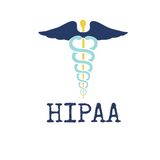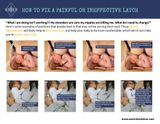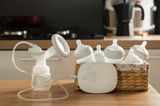As a new parent, the journey of breastfeeding and chestfeeding can be both rewarding and challenging. One of the obstacles some breastfeeding mothers or bodyfeeding parents face is the occurrence of vasospasms.
While vasospasms are not uncommon, they can be distressing and may lead to discomfort during this bonding experience with your baby. In this blog post, we will delve into what vasospasms are, what signs to look for if you suspect you might be experiencing them, and how to seek support and relief.
What Are Vasospasms?
Vasospasms, also known as Raynaud's phenomenon of the nipple, refer to the sudden constriction of blood vessels in the nipples. This constriction results in a temporary reduction in blood flow to the affected area, leading to intense, burning pain and a change in color – often turning white or bluish. Vasospasms can occur during or immediately after breastfeeding or chestfeeding, and the pain might persist for some time after the feeding session is over. Those with Raynaud’s prior to breastfeeding or chestfeeding will be more at risk for developing vasospasms in the nipple.
What Causes Vasospasms?
Vasospasms can be triggered by various factors, and understanding these causes can help in managing and preventing their occurrence:
- Temperature Changes: Exposure to cold temperatures can induce vasospasms, as the sudden drop in temperature affects blood circulation.
- Poor Latch: An improper latch during breastfeeding can cause nipple trauma and contribute to vasospasm development.
- Raynaud's Syndrome: Some parents may have a predisposition to vasospasms due to Raynaud's syndrome, a condition that affects blood vessels' response to temperature changes.
What to Look for if You Suspect Vasospasms
If you are experiencing sharp, burning pain in your nipples during or after breastfeeding or chestfeeding, it might be a sign of vasospasms. Here are some key symptoms to look out for:
- Intense Nipple Pain: The pain associated with vasospasms is often severe and can be described as throbbing or stabbing.
- Color Change: Noticeable changes in nipple color, such as turning white, bluish, or purple during and after breastfeeding.
- Sensitivity to Temperature: Nipples might feel extremely sensitive to temperature changes, with exposure to cold making the pain worse.
- Relief with Warmth: Applying warmth to the nipples, such as warm compresses, might temporarily alleviate the pain.
- Vasospasm or Thrush?: Vasospasms can often be confused with Thrush as both have a change in nipple color and can cause pain and burning. For more info about Thrush check out my blog post. Nipple thrush remedies And Oral thrush remedies.
Home remedies for vasospasms
Warm Compresses
Warm compresses can provide immediate relief from vasospasm-related pain. While many provider suggest soaking a soft cloth in warm water and gently apply it to the affected nipples for 10-15 minutes before and after breastfeeding or chestfeeding. I prefer using dry heat so when the heat pack is removed the nipple isn’t wet which causes it to cool more quickly than with dry heat. A rice sock is perfect for this. They even make small circular heat packs that can be placed in your top immediately after unlatching. Warmth helps dilate blood vessels, improving blood flow to the area and reducing discomfort.
Breast/chest Warm-Up
Before nursing, gently massage and warm your breasts or chest tissue to increase blood circulation to the nipples. A warm-up helps prepare your body for feeding, potentially reducing the occurrence of vasospasms.
Nipple Protection
Protecting your nipples from extreme cold can help prevent vasospasms triggered by temperature changes. Consider wearing soft, warm clothing and keeping your chest area well-insulated during colder weather
Wool Breast Pads
Wool breast pads have gained popularity as a natural and effective way to manage vasospasms. Unlike synthetic materials, wool has natural insulating properties that help regulate temperature and moisture around the nipples. This can be particularly beneficial for parents experiencing vasospasms triggered by exposure to cold temperatures.
Clinical evidence found that wool breast pads provided better temperature regulation and moisture management compared to traditional disposable pads.
Additionally, wool is a breathable material, which reduces the risk of bacterial growth and skin irritation. However, it is essential to choose high-quality wool breast pads and wash them regularly to maintain hygiene and prevent any potential issues.
Avoiding caffeine and other vasoconstrictors
Avoiding caffeine, nonselective beta-blockers, and vasoconstrictors, such as pseudoephedrine (can quickly decrease milk supply), is recommended as these compounds can contribute to blood vessel constriction, potentially worsening vasospasm-related pain and discomfort. Caffeine is known to cause vasoconstriction and can heighten sensitivity to cold temperatures, which might trigger or intensify vasospasms. Nonselective beta-blockers, often prescribed for certain medical conditions, can have a similar effect by inhibiting vasodilation. Additionally, vasoconstrictors like pseudoephedrine, found in many decongestant medications, can narrow blood vessels and contribute to the development of vasospasms.
The Importance of Improving Latch in the Treatment of Vasospasms
When dealing with the discomfort of vasospasms during breastfeeding or chestfeeding, improving latch is a fundamental aspect of treatment that should not be overlooked. A proper latch refers to the way your baby attaches to the breast or chest while nursing. Ensuring a correct latch can have a significant impact on reducing vasospasm-related pain and promoting overall breastfeeding or chestfeeding success. Here's why improving latch is crucial in the treatment of vasospasms:
Reducing Nipple Trauma
One of the primary causes of vasospasms is nipple trauma. An improper latch can lead to the misalignment of the baby's mouth and the nipple, causing friction and injury to the delicate nipple tissue. These injuries can trigger vasospasms as blood flow is compromised, leading to painful constriction of blood vessels. By improving latch, you can minimize nipple trauma and its associated complications, including vasospasm occurrence.
Proper Milk Transfer
A shallow latch or incorrect positioning can result in inefficient milk transfer during breastfeeding or chestfeeding. This means that your baby may not be getting enough milk or may be struggling to feed effectively. Poor milk transfer can lead to longer nursing sessions, which may increase the duration of exposure to cold air or temperature changes, triggering vasospasms. A better latch ensures that your baby can effectively extract milk, reducing the risk of extended feeding sessions and potential vasospasm episodes.
Enhancing Nipple Blood Flow
An optimal latch encourages a larger portion of the nipple to be covered by your baby's mouth. When the baby latches deeply, the nipple is positioned toward the back of the mouth, away from the pressure points of the gums and hard palate. This reduces compression on the blood vessels in the nipple, promoting better blood flow during and after breastfeeding or chestfeeding. Improved blood flow helps prevent vasospasms and ensures your nipples receive adequate oxygen and nutrients.
Enhancing Milk Ejection Reflex
The milk ejection reflex, also known as let-down, is the process by which milk is released from the milk ducts. A good latch triggers this reflex more effectively, allowing for a steady and consistent milk flow. A strong milk ejection reflex can help prevent prolonged or intermittent feeding sessions, minimizing the time that the nipples are exposed to potential triggers for vasospasms.
Promoting Comfortable Feeding
Aside from preventing vasospasms, improving latch enhances your overall breastfeeding experience by promoting comfort for both you and your baby. When your baby latches correctly, breastfeeding or chestfeeding should be a pain-free and enjoyable bonding experience. This encourages positive associations, which can benefit both you and your baby's emotional well-being.
Using L-Arginine to Treat Vasospasm
L-arginine is an amino acid that plays a crucial role in various physiological processes within the body. Among its many functions, L-arginine is known for its ability to promote vasodilation, which is the relaxation and widening of blood vessels. This property makes L-arginine a potentially effective treatment for vasospasms during breastfeeding.
How L-Arginine Works
When L-arginine is ingested, it is converted into nitric oxide (NO) through the action of enzymes called nitric oxide synthases. Nitric oxide is a powerful vasodilator that helps relax and widen blood vessels, improving blood flow to the affected areas. In the context of vasospasms, L-arginine supplementation aims to increase nitric oxide production, thereby reducing the constriction of blood vessels in the nipples and alleviating the associated pain and discomfort.
The Evidence: L-Arginine and Vasospasms
One such study, published in the Breastfeeding Medicine Journal, investigated the effects of L-arginine supplementation on nipple pain and vasospasms in a randomized controlled trial.
In this study, lactating mothers/parents experiencing vasospasms were divided into two groups. One group received L-arginine supplementation, while the other group received a placebo. The results revealed that the mothers who took L-arginine experienced a significant reduction in nipple pain and vasospasm frequency compared to the placebo group.
L-Arginine dosing for treatment of vasospasms
the articl in the Breastfeeding Medicine Journal suggests a dose of:
- l-arginine has been initiated at 1–2 g/day orally and titrated to 10 g/day as needed
- Many parents have seen results taking 500 mg, 3 times/day
Safety Considerations
L-arginine is generally considered safe for most breastfeeding/chestfeeding parents when taken in appropriate doses. However, as with any supplement, it is essential to consult with a healthcare professional before starting L-arginine supplementation. This is particularly crucial if you have any pre-existing medical conditions or are taking other medications, as L-arginine might interact with certain drugs or health conditions.
Obtaining L-Arginine Supplements
L-arginine supplements are readily available over-the-counter at drugstores, health stores, and online retailers. They come in various forms, including capsules, tablets, and powders. When selecting a supplement, opt for a reputable brand known for quality and safety. Follow the recommended dosage instructions provided on the packaging or as advised by your healthcare provider.
B6 supplementation for the treatment of Vasospasms
Vitamin B6 is a water-soluble vitamin that plays a crucial role in various physiological processes within the body, including nerve function and the metabolism of amino acids. Some research has suggested that B6 may have vasodilatory effects, promoting the relaxation and widening of blood vessels. Given the role of vasospasms in the constriction of blood vessels, it is hypothesized that B6 supplementation may help alleviate vasospasm-related pain and improve overall blood flow to the nipples.
How to Use B6 Supplementation
- B6 100 mg twice daily has been suggested for therapy of vasospasms.
- B6 can be taken with L-arginine
- If you are considering B6 supplementation to treat vasospasms, it is essential to consult with your healthcare provider first. They can guide you on the appropriate dosage based on your individual needs and medical history. B6 supplements are available in various forms, including capsules, tablets, and liquid formulations.
Caution and Considerations
While B6 supplementation shows promise as a potential treatment for vasospasms, it is crucial to exercise caution when taking any supplement. Excessive intake of vitamin B6 can lead to toxicity and adverse effects. Therefore, it is essential to follow the recommended dosage provided by your healthcare provider and avoid self-prescribing B6 supplements without professional guidance.
Medication Options for Treating Vasospasms
While home remedies and lifestyle adjustments can provide relief for some nursing parents experiencing vasospasms, some cases may require additional medical intervention. Medications can play a crucial role in managing vasospasm-related pain and discomfort. Consult with your prescribing health care provider to find out what option is best for you. Here are some medication options commonly considered for treating vasospasms:
Topical Nifedipine
Nifedipine is a calcium channel blocker that is commonly prescribed in the treatment of vasospasms. When applied topically to the affected nipples, nifedipine works by relaxing the smooth muscles of the blood vessels, promoting vasodilation, and improving blood flow to the area. By reducing the constriction of blood vessels, topical nifedipine can alleviate the pain and discomfort associated with vasospasms.
How to Use Topical Nifedipine:
- Topical nifedipine preparations usually come in the form of a 0.2% ointment.
- A small amount of the ointment is applied to the affected nipples after each breastfeeding session or as directed by your healthcare provider.
- Make sure to wash your hands thoroughly before and after applying the ointment.
Oral Nifedipine
In cases where topical nifedipine is not sufficient to manage vasospasm symptoms, healthcare providers may prescribe oral nifedipine. Oral nifedipine works in a similar way to its topical counterpart, relaxing blood vessels throughout the body and promoting overall vasodilation.
How to Take Oral Nifedipine:
- Oral nifedipine is typically available in the form of extended-release tablets or capsules.
- The dosage and frequency of administration will be determined by your healthcare provider based on your specific needs and medical history.
- It is crucial to follow the prescribed dosage and not to adjust it without consulting your healthcare provider.
Diltiazem Cream
Diltiazem is another calcium channel blocker that can be used in the form of a topical cream to manage vasospasms. Similar to nifedipine, diltiazem cream relaxes blood vessels and improves blood flow, reducing the occurrence and severity of vasospasms.
How to Use Diltiazem Cream:
- Diltiazem cream is typically applied to the affected nipples after each breastfeeding session or as directed by your healthcare provider.
- As with any medication, it is essential to follow the prescribed dosage and usage instructions.
Antidepressants
In some cases, healthcare providers may consider prescribing low-dose antidepressants, such as certain selective serotonin reuptake inhibitors (SSRIs) or tricyclic antidepressants, to manage vasospasms. These medications have been found to have vasodilatory effects, which can help improve blood flow and reduce vasospasm-related pain.
Seeking Support and Relief
Experiencing vasospasms can be distressing, but there are steps you can take to seek support and find relief:
- Reach Out to a Lactation Consultant: A certified lactation consultant can observe your breastfeeding/chestfeeding technique and provide guidance on improving latch and positioning, which may help alleviate vasospasm pain. They can guide you with through all available options and connect with your healthcare providers.
- Consult with a Healthcare Professional: If you suspect vasospasms or have persistent nipple pain, consult with your healthcare provider to rule out other potential causes and explore treatment options.
Vasospasms can be a challenging experience during your breastfeeding/chestfeeding journey, but knowing what to look for and seeking appropriate support can make a significant difference. If you suspect you might be experiencing vasospasms, try some of the at home remedies mentioned here and if you are not experiencing relief reach out to a lactation consultant or healthcare professional to explore possible causes and effective treatments. Remember that each breastfeeding/chestfeeding journey is unique, and with the right support, you can overcome vasospasms and continue to cherish the precious moments with your baby.
[Note: The links provided are affiliate links. Making a purchase through these links will provide a small commission to support the blog without any additional cost to you. We appreciate your trust and support!]
Rerfrences:
https://www.liebertpub.com/doi/full/10.1089/bfm.2020.0198






